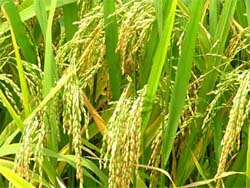
CAS scientists proposed lately the building of a fourth rice production base in Northeast China by fully taping the resources of ancient river channels in the western part of the region so as to promote the local economic and ecological development.
The new base will not only serve as a strong support to the three existing rice producing bases respectively in the Sanjiang Plain, the Liaohe Plain and the eastern mountainous areas, but confirm the region's status as one of China's major commodity grain producers to ensure the nation's food-supply security, said Prof. SUN Guangyou from the CAS Northeast Institute of Geography and Agroecology.
According to Prof. Sun, the western part of Northeast China has great potential for rice production thanks to the local ancient channels. The region, lying in the arm of west Songnen Plain, covers a total area over 11.5 million hectares and nurtures some 10 million people in 29 cities and counties of Jilin and Heilongjiang provinces as well as the Inner Mongolia Autonomous Region. One of the three biggest soda-containing saline-alkali lands in the world, it comprises of over 3.73 million hectares of alkali soil, and the degree of soil salinization and alkalization has reached as high as 0.8. Meanwhile, the Plain is endowed with 24 ancient river channels covering about 2 million hectares of land, 70% of which is saline-alkali wasteland and low-yielding soil.
As to the feasibility of growing rice in saline-alkali soil in the region, Sun explained that his research group has been working on the subject ever since 1989 and successful experiments were carried out back in 1994. Planting rice as a pilot project in west Jilin Province for over 15 years, Sun and his colleagues confirmed the possibility of developing large-scale high-quality paddy fields in the region. They discovered that the virgin soils along these ancient channels are meadow and bog soils containing high fertility for rice growth once they are dealkalized.
Sun and co-workers conducted the experiment in a local village in Da'an City, Jilin Province, a place that is hard hit by salinization and alkalization with alkali dusts all over in the air. Thanks to their efforts of controlling salinization and alkalization by growing rice, now the acreage of paddy fields along the ancient channels totals up to 1,333 hectares with an average rice output of 8,000 kg per hectare, and the environment conditions have been greatly improved over the past decade. They provide strong evidence and good experience for the rice production base in the western part of Northeast China.
In 2005, the construction of irrigation areas was kicked off in Da'an as one of the six key projects of Jilin Province during the 11th Five-Year Plan period (2006-2010). The government planned to earmark 1.2 billion yuan (or US$ 160 million) to reform 87,500 hectares land, making it the largest irrigation area across Northeast China.
The new base is going to have safe water resources too, Prof. Sun pointed out. Data showed that the entire surface and underground water volume within the Nenjiang River drainage area stands at some 36.78 billion m3, only 18.1% of which has been used, and the region has only 245 thousand hectares paddy fields by far. On other hand, the total water volume of the Second Songhua River is estimated to be 41.16 billion m3. Once well deployed, 6.5 billion m3 waters from the two rivers can be used for irrigation, while less than a tenth of that amount is needed to support an increase of paddy fields to some 667,000 hectares in all.
With all the above factors in consideration, Prof. Sun put forward three guidelines for building the new base in western Northeast China. First of all, its development pattern should be well designed in advance. Along ancient channels at lower reaches of the Songnen Plain, saline-alkali and degraded lands shall be revived with waters from rivers or underground to build a vast belt of rice plantations. It will hopefully speed up the reconstruction of low-yielding fields, the ecological restoration of wetland, and the nursing of grassland and reed field, boosting fast economic development in the region.
Secondly, a modern and integrated agricultural industry belt shall be established, featuring a combination of commodity grain, meat, milk, breeding and reed producing. In addition, major natural landscapes such as the grassland, bulrush and wetland will be restored in the region.
Thirdly, to address local environmental and ecological problems, importance shall be attached to the management of deserts as well as degraded grasslands, reeds and water areas. A number of State-level wetlands shall be built to form a large wetland barrier for ecological protection in the western part of China.







